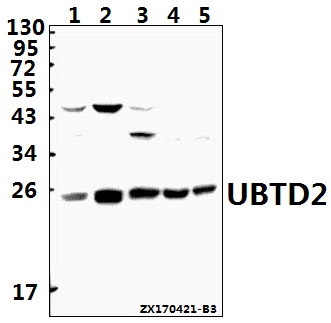Product Name :
UBTD2 polyclonal antibody Background :
UBTD2 (ubiquitin domain containing 2), also known as DCUBP (dendritic cell-derived ubiquitin-like protein), DC-UbP or SB72, is a 234 amino acid cytoplasmic and mitochondrial ubiquitin-like (UbL) protein that contains one C-terminal UbL domain. UbL proteins are involved in a variety of cellular processes, including DNA repair, protein sorting, apoptosis, protein degradation, cell division and autophagy. Predominantly expressed in dendritic cells and detected at high levels in tumor cell lines, UBTD2 has been implicated in apoptosis, cellular differentiation and tumorigenesis. The UbL domain of UBTD2 is 55% similar and 28.6% identical to the amino acid sequence of ubiquitin, but it lacks the Gly-Gly motif that is essential for ubiquitination. As its UbL domain does not actively ubiquitinate proteins, UBTD2 is believed to function as a shuttle factor involved in the ubiquitin system. Product :
Rabbit IgG, 1mg/ml in PBS with 0.02% sodium azide, 50% glycerol, pH7.2 Storage&Stability :
Store at 4°C short term. Aliquot and store at -20°C long term. Avoid freeze-thaw cycles. Specificity :
UBTD2 polyclonal antibody detects endogenous levels of UBTD2 protein. Immunogen :
Synthetic peptide, corresponding Human UBTD2. Conjugate :
Unconjugated Modification :
Unmodification
UBTD2 polyclonal antibody Background :
UBTD2 (ubiquitin domain containing 2), also known as DCUBP (dendritic cell-derived ubiquitin-like protein), DC-UbP or SB72, is a 234 amino acid cytoplasmic and mitochondrial ubiquitin-like (UbL) protein that contains one C-terminal UbL domain. UbL proteins are involved in a variety of cellular processes, including DNA repair, protein sorting, apoptosis, protein degradation, cell division and autophagy. Predominantly expressed in dendritic cells and detected at high levels in tumor cell lines, UBTD2 has been implicated in apoptosis, cellular differentiation and tumorigenesis. The UbL domain of UBTD2 is 55% similar and 28.6% identical to the amino acid sequence of ubiquitin, but it lacks the Gly-Gly motif that is essential for ubiquitination. As its UbL domain does not actively ubiquitinate proteins, UBTD2 is believed to function as a shuttle factor involved in the ubiquitin system. Product :
Rabbit IgG, 1mg/ml in PBS with 0.02% sodium azide, 50% glycerol, pH7.2 Storage&Stability :
Store at 4°C short term. Aliquot and store at -20°C long term. Avoid freeze-thaw cycles. Specificity :
UBTD2 polyclonal antibody detects endogenous levels of UBTD2 protein. Immunogen :
Synthetic peptide, corresponding Human UBTD2. Conjugate :
Unconjugated Modification :
Unmodification
-
 Western blot (WB) analysis of UBTD2 polyclonal antibody at 1:500 dilution Lane1:SGC7901 whole cell lysate(40ug) Lane2:HepG2 whole cell lysate(40ug) Lane3:A549 whole cell lysate(40ug) Lane4:CT26 whole cell lysate(40ug) Lane5:PC12 whole cell lysate(40ug)
Western blot (WB) analysis of UBTD2 polyclonal antibody at 1:500 dilution Lane1:SGC7901 whole cell lysate(40ug) Lane2:HepG2 whole cell lysate(40ug) Lane3:A549 whole cell lysate(40ug) Lane4:CT26 whole cell lysate(40ug) Lane5:PC12 whole cell lysate(40ug)
Bioworld Biotech only provide peptides for our antibodies and do not provide additional peptide customization services.
Price/Size :
USD 368/1mg/vial
Tips:
For phospho antibody, we provide phospho peptide(0.5mg) and non-phospho peptide(0.5mg).Describe :
Blocking peptides are peptides that bind specifically to the target antibody and block antibody binding. These peptide usually contains the epitope recognized by the antibody. Antibodies bound to the blocking peptide no longer bind to the epitope on the target protein. This mechanism is useful when non-specific binding is an issue, for example, in Western blotting (WB) and Immunohistochemistry (IHC). By comparing the staining from the blocked antibody versus the antibody alone, one can see which staining is specific; Specific binding will be absent from the western blot or IHC performed with the neutralized antibody.Formula:
Synthetic peptide was lyophilized with 100% acetonitrile and is supplied as a powder. Reconstitute with 0.1 ml DI water for a final concentration of 10 mg/ml.The purity is >90%,tested by HPLC and MS.
Storage:
The freeze-dried powder is more stable. For short time at 2-8°C. For long term storage store at -20°C.
Note :
This product is for research use only (RUO only). Not for use in diagnostic or therapeutic procedures.
 UBTD2 polyclonal antibody
UBTD2 polyclonal antibody  Datasheet
Datasheet COA
COA MSDS
MSDS SHIP
SHIP